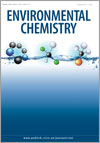EN12096Competitive ligand exchange reveals time dependant changes in the reactivity of Hg–dissolved organic matter complexes
Environmental context. Mercury, a globally important pollutant, undergoes transformations in the environment to form methylmercury that is toxic to humans. Naturally occurring dissolved organic matter is a controller in these transformations, and we demonstrate that its strength of interaction with mercury is time dependent. These changes in complexation with dissolved organic matter are likely to affect mercury’s reactivity in aquatic systems, thereby influencing how mercury is methylated and bioaccumulated.
EN12096 Abstract | EN12096 Full Text | EN12096PDF (239 KB) | EN12096Supplementary Material (291 KB) Open Access Article




